Module 7 Great books 模块整体教学设计(表格式)
文档属性
| 名称 | Module 7 Great books 模块整体教学设计(表格式) |
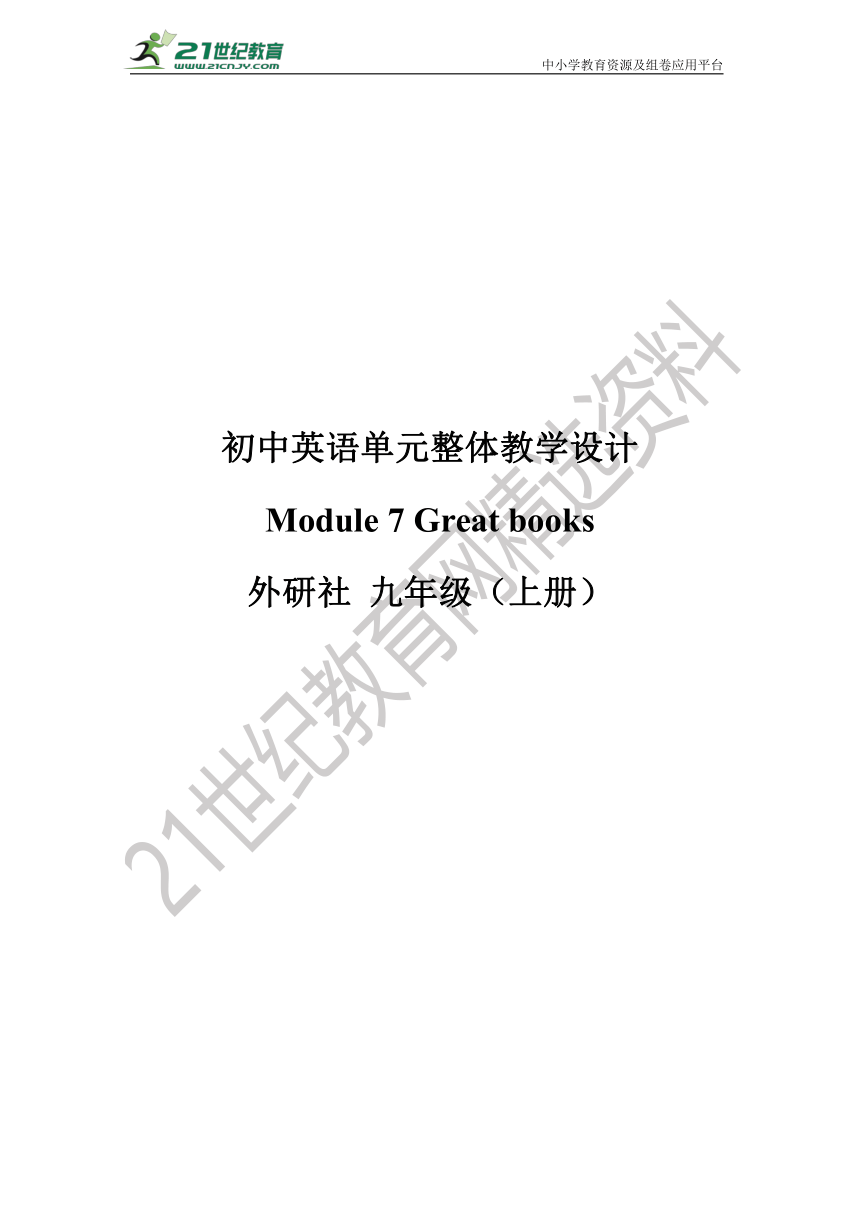
|
|
| 格式 | docx | ||
| 文件大小 | 270.5KB | ||
| 资源类型 | 试卷 | ||
| 版本资源 | 外研版 | ||
| 科目 | 英语 | ||
| 更新时间 | 2023-08-04 13:57:00 | ||
图片预览

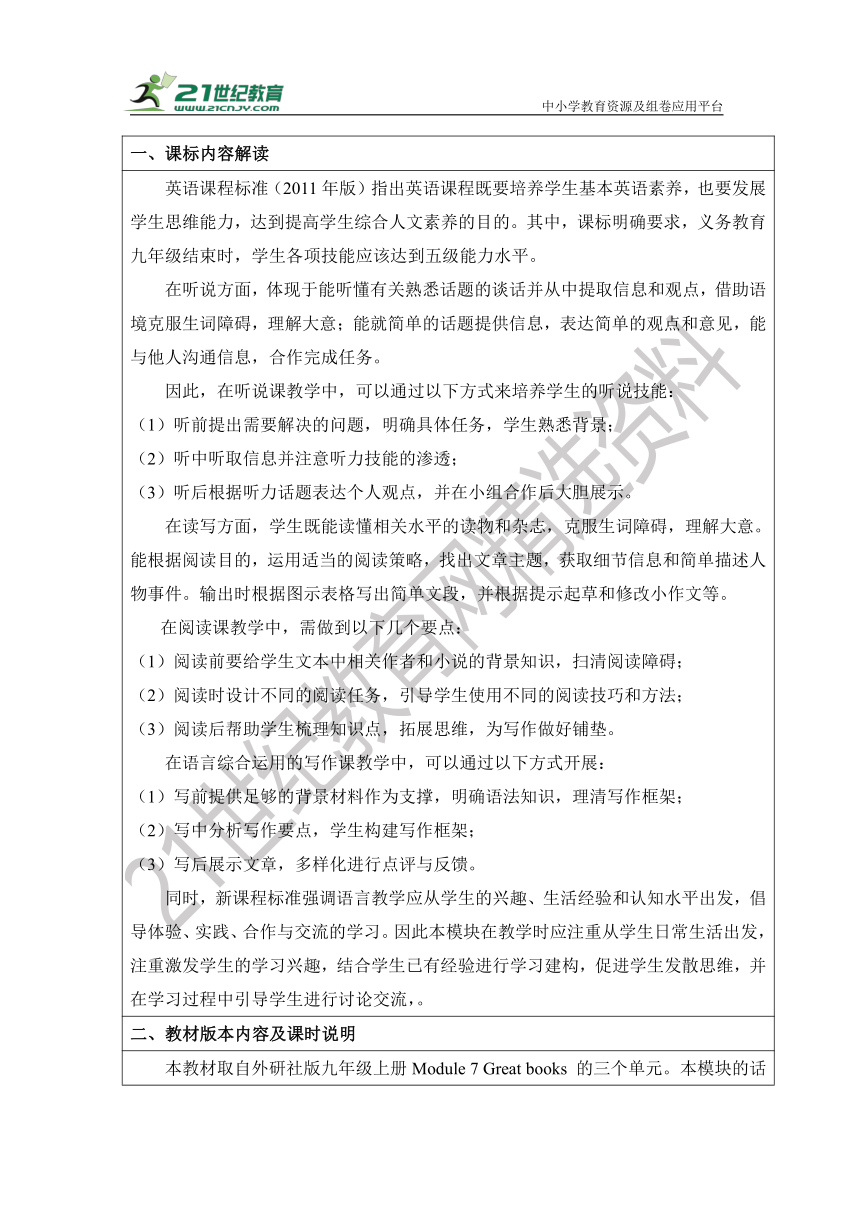
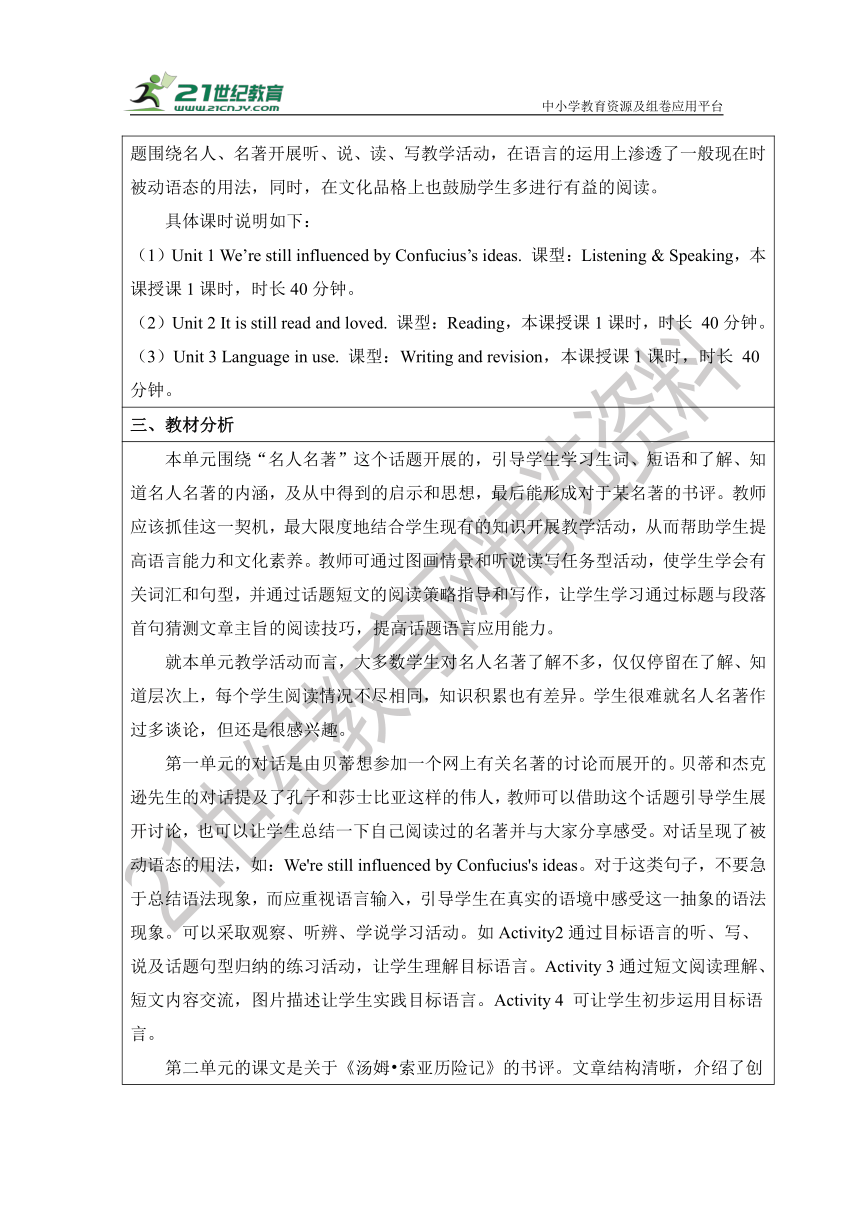
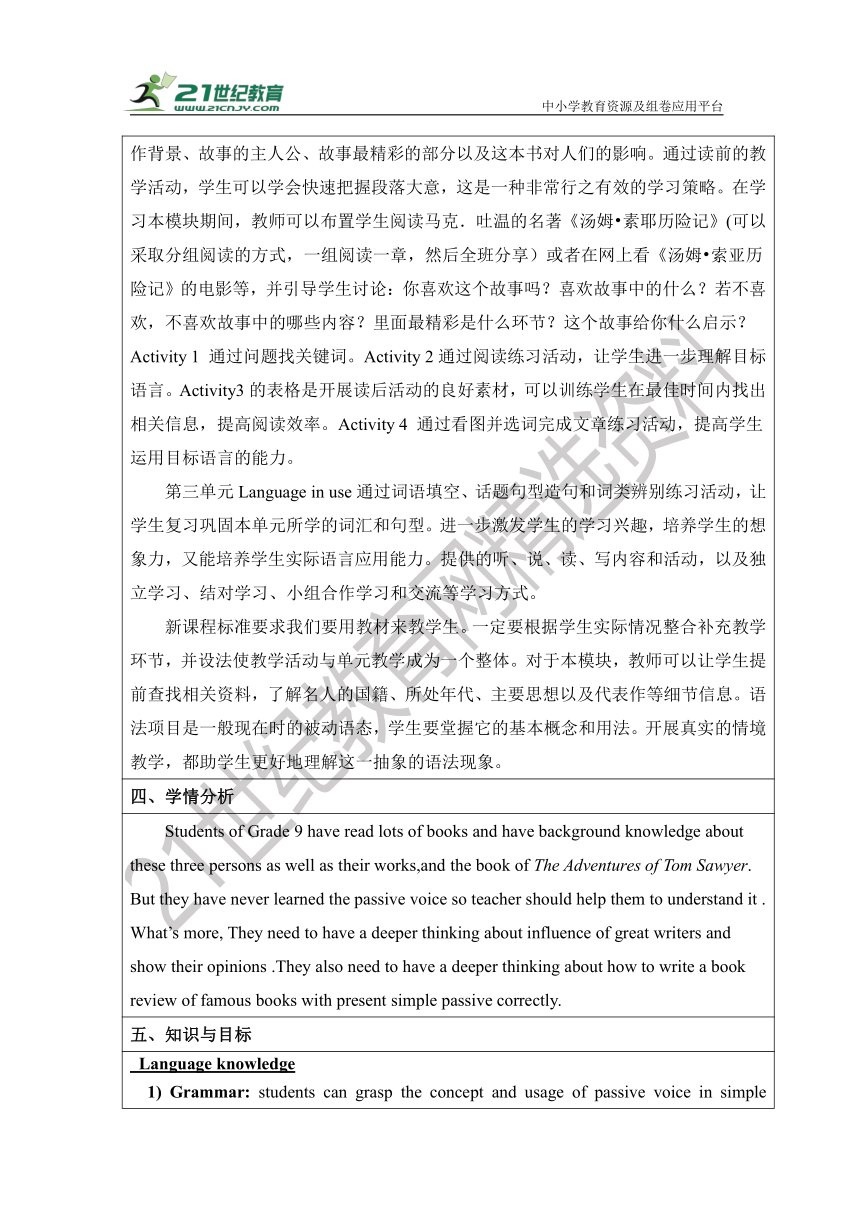
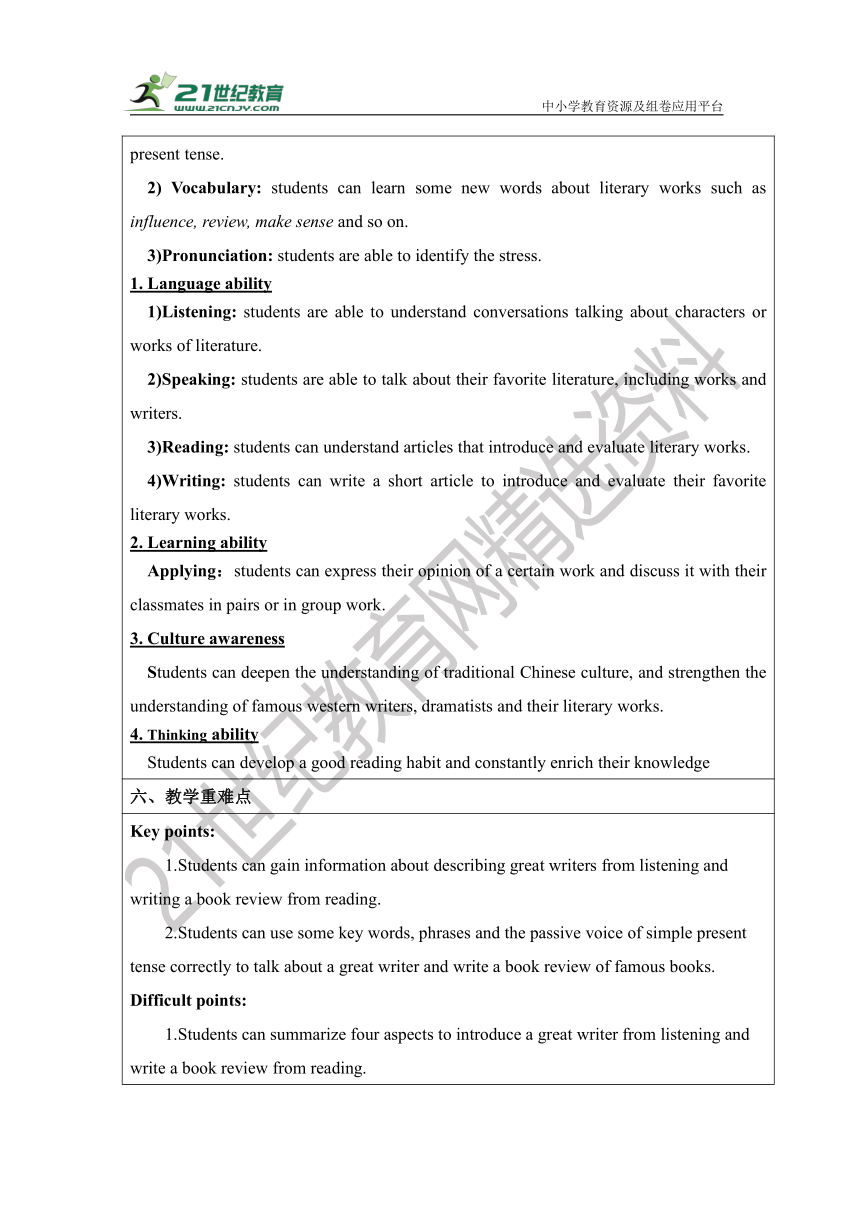
文档简介
初中英语单元整体教学设计
Module 7 Great books
外研社 九年级(上册)
中小学教育资源及组卷应用平台
一、课标内容解读
英语课程标准(2011年版)指出英语课程既要培养学生基本英语素养,也要发展学生思维能力,达到提高学生综合人文素养的目的。其中,课标明确要求,义务教育九年级结束时,学生各项技能应该达到五级能力水平。 在听说方面,体现于能听懂有关熟悉话题的谈话并从中提取信息和观点,借助语境克服生词障碍,理解大意;能就简单的话题提供信息,表达简单的观点和意见,能与他人沟通信息,合作完成任务。 因此,在听说课教学中,可以通过以下方式来培养学生的听说技能: (1)听前提出需要解决的问题,明确具体任务,学生熟悉背景; (2)听中听取信息并注意听力技能的渗透; (3)听后根据听力话题表达个人观点,并在小组合作后大胆展示。 在读写方面,学生既能读懂相关水平的读物和杂志,克服生词障碍,理解大意。能根据阅读目的,运用适当的阅读策略,找出文章主题,获取细节信息和简单描述人物事件。输出时根据图示表格写出简单文段,并根据提示起草和修改小作文等。 在阅读课教学中,需做到以下几个要点: (1)阅读前要给学生文本中相关作者和小说的背景知识,扫清阅读障碍; (2)阅读时设计不同的阅读任务,引导学生使用不同的阅读技巧和方法; (3)阅读后帮助学生梳理知识点,拓展思维,为写作做好铺垫。 在语言综合运用的写作课教学中,可以通过以下方式开展: (1)写前提供足够的背景材料作为支撑,明确语法知识,理清写作框架; (2)写中分析写作要点,学生构建写作框架; (3)写后展示文章,多样化进行点评与反馈。 同时,新课程标准强调语言教学应从学生的兴趣、生活经验和认知水平出发,倡导体验、实践、合作与交流的学习。因此本模块在教学时应注重从学生日常生活出发,注重激发学生的学习兴趣,结合学生已有经验进行学习建构,促进学生发散思维,并在学习过程中引导学生进行讨论交流,。
二、教材版本内容及课时说明
本教材取自外研社版九年级上册Module 7 Great books 的三个单元。本模块的话题围绕名人、名著开展听、说、读、写教学活动,在语言的运用上渗透了一般现在时被动语态的用法,同时,在文化品格上也鼓励学生多进行有益的阅读。 具体课时说明如下: (1)Unit 1 We’re still influenced by Confucius’s ideas. 课型:Listening & Speaking,本课授课1课时,时长40分钟。 (2)Unit 2 It is still read and loved. 课型:Reading,本课授课1课时,时长 40分钟。 (3)Unit 3 Language in use. 课型:Writing and revision,本课授课1课时,时长 40分钟。
三、教材分析
本单元围绕“名人名著”这个话题开展的,引导学生学习生词、短语和了解、知道名人名著的内涵,及从中得到的启示和思想,最后能形成对于某名著的书评。教师应该抓佳这一契机,最大限度地结合学生现有的知识开展教学活动,从而帮助学生提高语言能力和文化素养。教师可通过图画情景和听说读写任务型活动,使学生学会有关词汇和句型,并通过话题短文的阅读策略指导和写作,让学生学习通过标题与段落首句猜测文章主旨的阅读技巧,提高话题语言应用能力。 就本单元教学活动而言,大多数学生对名人名著了解不多,仅仅停留在了解、知道层次上,每个学生阅读情况不尽相同,知识积累也有差异。学生很难就名人名著作过多谈论,但还是很感兴趣。 第一单元的对话是由贝蒂想参加一个网上有关名著的讨论而展开的。贝蒂和杰克逊先生的对话提及了孔子和莎士比亚这样的伟人,教师可以借助这个话题引导学生展开讨论,也可以让学生总结一下自己阅读过的名著并与大家分享感受。对话呈现了被动语态的用法,如:We're still influenced by Confucius's ideas。对于这类句子,不要急于总结语法现象,而应重视语言输入,引导学生在真实的语境中感受这一抽象的语法现象。可以采取观察、听辨、学说学习活动。如Activity2通过目标语言的听、写、说及话题句型归纳的练习活动,让学生理解目标语言。Activity 3通过短文阅读理解、短文内容交流,图片描述让学生实践目标语言。Activity 4 可让学生初步运用目标语言。 第二单元的课文是关于《汤姆 索亚历险记》的书评。文章结构清哳,介绍了创作背景、故事的主人公、故事最精彩的部分以及这本书对人们的影响。通过读前的教学活动,学生可以学会快速把握段落大意,这是一种非常行之有效的学习策略。在学习本模块期间,教师可以布置学生阅读马克.吐温的名著《汤姆 素耶历险记》(可以采取分组阅读的方式,一组阅读一章,然后全班分享)或者在网上看《汤姆 索亚历险记》的电影等,并引导学生讨论:你喜欢这个故事吗?喜欢故事中的什么?若不喜欢,不喜欢故事中的哪些内容?里面最精彩是什么环节?这个故事给你什么启示?Activity 1 通过问题找关键词。Activity 2通过阅读练习活动,让学生进一步理解目标语言。Activity3的表格是开展读后活动的良好素材,可以训练学生在最佳时间内找出相关信息,提高阅读效率。Activity 4 通过看图并选词完成文章练习活动,提高学生运用目标语言的能力。 第三单元Language in use通过词语填空、话题句型造句和词类辨别练习活动,让学生复习巩固本单元所学的词汇和句型。进一步激发学生的学习兴趣,培养学生的想象力,又能培养学生实际语言应用能力。提供的听、说、读、写内容和活动,以及独立学习、结对学习、小组合作学习和交流等学习方式。 新课程标准要求我们要用教材来教学生。一定要根据学生实际情况整合补充教学环节,并设法使教学活动与单元教学成为一个整体。对于本模块,教师可以让学生提前查找相关资料,了解名人的国籍、所处年代、主要思想以及代表作等细节信息。语法项目是一般现在时的被动语态,学生要堂握它的基本概念和用法。开展真实的情境教学,都助学生更好地理解这一抽象的语法现象。
四、学情分析
Students of Grade 9 have read lots of books and have background knowledge about these three persons as well as their works,and the book of The Adventures of Tom Sawyer. But they have never learned the passive voice so teacher should help them to understand it . What’s more, They need to have a deeper thinking about influence of great writers and show their opinions .They also need to have a deeper thinking about how to write a book review of famous books with present simple passive correctly.
五、知识与目标
Language knowledge 1) Grammar: students can grasp the concept and usage of passive voice in simple present tense. 2) Vocabulary: students can learn some new words about literary works such as influence, review, make sense and so on. 3)Pronunciation: students are able to identify the stress. 1. Language ability 1)Listening: students are able to understand conversations talking about characters or works of literature. 2)Speaking: students are able to talk about their favorite literature, including works and writers. 3)Reading: students can understand articles that introduce and evaluate literary works. 4)Writing: students can write a short article to introduce and evaluate their favorite literary works. 2. Learning ability Applying:students can express their opinion of a certain work and discuss it with their classmates in pairs or in group work. 3. Culture awareness Students can deepen the understanding of traditional Chinese culture, and strengthen the understanding of famous western writers, dramatists and their literary works. 4. Thinking ability Students can develop a good reading habit and constantly enrich their knowledge
六、教学重难点
Key points: 1.Students can gain information about describing great writers from listening and writing a book review from reading. 2.Students can use some key words, phrases and the passive voice of simple present tense correctly to talk about a great writer and write a book review of famous books. Difficult points: 1.Students can summarize four aspects to introduce a great writer from listening and write a book review from reading. 2.Students can give a speech about a great writer and write a book review of famous books by using the passive voice of simple present tense correctly .
七、教法学法分析
Teaching methods: Task-based language teaching; Situational teaching method. Learning methods: Individual learning and cooperative learning
八、单元教学过程
Unit 1 We’re still influenced by Confucius’s ideas. TypeListening&SpeakingPeriod40 minutesAnalysis of This unit This unit talks about three great persons, including Confucius,Shakespeare and Mark Twain. This dialogue is between Mr Jackson and Betty, expressing their opinions about the three great persons and showing supportive or different ideas to others’ views. Besides, passive voice of simple present tense is used to describe the subject of a sentence is acted upon by the verb. Give examples about supporting or opposing others’ view and develop the awareness about learning good traits form the great person.Teaching aims of this unitBy the end of this lesson, students will be able to: Language ability a.grasp some key information of the conversation about great writers and their influence from listening. b.talk about great writers with the key words, expressions and structures:thinker, wise, well-known, make sense, ...are read/influenced by..., I think/accept/suppose.... Learning ability a.improve the ability of prediction before listening. b.develop speaking ability when finishing the unit task. Thinking quality a.form the logical thinking of how to talk about a great writer from four aspects. b.have a deep thinking about what are great books like and why are they called great books. Cultural awareness understand the importance of reading and raise the awareness of reading more great books.Key points and difficult points of this unitKey points: 1.Students can gain information about describing great writers from listening; 2.Students can use some key words, phrases and the passive voice of simple present tense correctly to talk about a great writer. Difficult points: 1.Students can summarize four aspects to introduce a great writer from listening; 2.Students can give a speech about a great writer by using the passive voice of simple present tense.Teaching proceduresStepsTeacher’s activityStudents’ activityPurposeStep 1 Warm up (3 min)1.Greeting 2.Show some books and ask students “Are they great books ” 3.Guide students to think about “What are great books like Why do people call them great books ”1.Get ready for the class 2.Look at the books and answer if they are great books. 3.Have a thinking about the qualities of great books.1.To arouse students’ interest in learning this topic by showing their familiar books. 2.To activate students’ background knowledge about great books. Step 2 Pre-listening (5min)1.Lead in the topic by introducing Confucius and one of his ideas. 2.Introduce the unit task:to give a speech about great writers. 3.Play a video and ask three questions: How many writers are there b.Who are they c.What are their great works Learn about Confucius by guessing the idea from him. Understand the unit task and get ready for it. Watch the video and find out the answers.To lead in the topic and get students understand the purpose of this class. To help students gain more information about the three persons.Step 3 While-listening (10min)Guide students to make a prediction before listening tasks. Encourage students to gain useful information about introducing a great writer by finishing the mind map.Predict what they may hear. Listen and find out the answers. Multiple choices Listen and fill in the blanks. 3.To figure out different aspects of introducing a great writer.1.To improve the ability of prediction before listening. 2.To find the target knowledge about introducing a great writer. Step 4 Post-listening (20 min) 1.Guide students to find out how to show opinions in the dialogue; Perfect the mind map . Encourage students to practise using the mind map by introducing Confucius. Ask students to work in groups to choose one great writer and introduce him/her. Read the dialogue and find out the opinions of Mr Jackson as well as Betty. Add more information to the mind map. Practise the mind map in pairs Talk in groups and introducing their groups’ favourite writer.To guide students understand the structure of showing opinions. To help students realize how to introduce a great writer from four aspects and practise using it. To introduce a great writer. Summary and homework (2 min)1.Review what we’ve learned by showing the mind map. 2.Encourage students to have a deep thinking about reading books.1.Recall the knowledge about introducing a great writer. 2.Understand the importance of reading great books.1.To strengthen what we’ve learned in this class. 2.To raise the awareness of reading more great books. Blackboard design Module 7 Great books Unit 1 We’re still influenced by Confucius’s ideas. Influence: 1.His/Her works are read by... 2.We're still influenced by... 3.His/Her works make a lot of sense. Opinion: I think/accept/suppose...
Unit 2 It is still read and loved. TypeReadingPeriod40 minutesAnalysis of This unit This unit talks about book review of The Adventures of Tom Sawyer , including the background,the story and the writer’s review of the book. This passage talks about four aspects of book review so students are able to learn how to write a book review step by step through reading the passage. Besides, passive voice of simple present tense is used to describe the subject of a sentence is acted upon by the verb. Students can understand the passive voice deeply by passage.Teaching aims of this unitBy the end of this lesson, students will be able to: 1)Language ability Grasp some key information of the conversation about A book review of The Adventures of Tom Sawyer. b.Talk about great writers with the key expressions :be set in,get into trouble,run away,escape from,for a time,be surprised to do,be thought to be... 2)Learning ability a. Improve the ability of prediction before reading. b.Develop reading ability when finishing the unit task. 3)Thinking quality a.Form the logical thinking of how to write a book review of famous books from five aspects. b.Have a deep thinking about the meanings from the Great books. 4)Cultural awareness Understand the importance of reading and raise the awareness of reading more great books. Cultivate more key competence from the reading.Key points and difficult points of this unitKey points: 1.Students can gain information about writing a book review from reading. 2.Students can use some key words, phrases and the passive voice of simple present tense correctly to write famous books. Difficult points: 1.Students can summarize five aspects to write a book review from reading. 2.Students can write a passage about a famous book by using the passive voice of simple present tense correctly.Teaching proceduresStepsTeacher’s activityStudents’ activityPurposeStep 1 Warm up(2 mins)1.Greeting 2.Show some books and ask students “What are great books ” 3.Guide students to think about “What are great books like Why do people call them great books ”1.Get ready for the class. 2.Look at the books and answer if they are great books. 3.Have a thinking about the qualities of great books.1.To arouse students’ interest in learning this topic by showing their familiar books. 2.To activate students’ background knowledge about great books. Step 2 Pre-reading (3mins)1.Lead in the topic by introducing Mark Twain and his famous books. 2.Introduce the unit task:how to write a book review. 3.By reading the mind map and learn about the five aspects of the story.1.Learn about Mark Twain by reading the information from him. 2.Read a mind map and try to understand five aspects of the story.1.To lead in the topic and get students understand the purpose of this class. 2.To help students learn about more information to write a book view.Step 3 While-reading (15mins)1.Guide students how to find the answers quickly by fast reading. 2.Guide students how to find the detail information by careful reading. a.Read para 1 and encourage students to gain useful information about the basic information by finishing the mind map. b.Read paragraph 2 and choose the best answers. c.Read paragraph 3 and answer the following questions. d.Read para 4 and check T/F and correct the answers.1.Fast reading:Match the paragraph to the titles. 2.Read and finish the mind map. 3.Multiple choices to know about para2. 4.Answer the questions to understand some details of para3 5.Check T/F.and correct the wrong answers to know the para4.1.To improve the ability of prediction before reading. 2.To find the target knowledge about A book review of The Adventures of Tom Sawyer. Step 4 Post-reading (20 mins) 1.Guide students to find out how to write a book review of The Adventures of Tom Sawyer. 2.Perfect the table. 3.Encourage students to practise using the table by introducing The Adventures of Tom Sawyer. 4.Ask students to work in groups and choose famous books to write a book review. 1.Read the dialogue and find out how to write a book review. 2.Add more information to the table. 3.Practise the table in pairs. 4.Discuss in groups and introduce their groups’ famous book.1.To guide students understand the structure of showing opinions. 2.To help students realize how to write a book review from five aspects and practise using them. 3.To introduce a famous book. Summary and homework (2 min)1.Review what we’ve learned by showing the table. 2.Encourage students to have a deep thinking about Great books.1.Recall the knowledge about a book review of The Adventures of Tom Sawyer. 2.Understand the importance of reading great books.1.To strengthen what we’ve learned in this class. 2.To raise the awareness of reading more great books. Blackboard design Module 7 Great books Unit 1 Unit 2 It is still read and loved. Important phrases: 1.be set in 2.get into trouble 3.run away 4.escape from 5.for a time 6.be surprised to do sth 7.be thought to be Difficult sentences: 1.It is still read and loved. 2.It is written in everyday English.
Unit 3 Language in use TypeWriting and revisionPeriod40 minutesAnalysis of This unit: The topic Great Books is authentic and related to students’ real life, so it can arouse students’ interest and their prior knowledge. : Learning the grammar rules of present simple passive in context is able to prepare students to use it in real life. : Students have already gained some inputs in Unit 1 and 2, which makes the grammar rules more accessible to them. Teaching aims of this unitBy the end of this lesson, students will be able to: 1) Language ability a.understand the form and meaning of present simple passive. b.use present simple passive in spoken and written contexts. c.share their favourite books with classmates and get to know more information about great books and great writers. 2) Learning ability develop writing ability when finishing the unit task. 3) Thinking quality form the logical thinking of how to write a passage about their favourite books and writers from different aspects. 4) Cultural awareness raise awareness of learning about the great books of great writers around the world and love reading.Key points and difficult points of this unitKey points: The structure of present simple passive. Difficult points: Students can write a composition about their favourite books and writers with present simple passive appropriately.Teaching proceduresStepsTeacher’s activityStudents’ activityPurposeStep 1 Lead in/Greetings Set a task: One of our classmates wants to share her favourite book on the programme Reader. But to be invited to this programme, she needs to go through some challenges. Let’ s help her together!Get ready for the class .Watch a video of a students, and be ready to take some challenges to help her.It is essential to arouse students’ interest and lead students into the teaching situation.Step 2 PresentationChallenge 1: Get your words and expressions ready.Play a game: Sharp eyes. When students see the words or the expressions in the ppt, read them loudly.Look at the blackboard, when they see the word, speak out loudly.Review the key words and sentence structures in this unit, make preparation for the writing.Challenge 2: Be familiar with some writers and their works.Show the picture of Lun Yu, Romeo and Juliet and The Adventure of Tom Sawyer, let students have a free talk.Review some knowledge they learnt in unit 1 and unit 2, talk about the books shown in the ppt with classmates.Review what students have learnt in Unit 1 and Unit 2. Step 3 PracticeChallenge 3: Practise expressing with active voice and passive voice.Guide students to find out how to distinguish passive voice from passive plete the sentences with the correct form of the words in the box. Students need to use the words more than once.It is the guided discovery method that helps students to work out the grammar rules from the example passage. Also, this activity is a platform to implement mechanical practice and aim at form accuracy by distinguishing passive voice from active voice.Challenge 4: Show us how to make a book review.Show students the passage of Unit 2, find out what a book review need. Guide students to conclude the elements of a book review.Review the passage of Unit 2, find out what elements a book review have. Conclude the elements of a book review.Find out the structure of a book review by students themselves to get ready for the writing task.Challenge 5: A rehearsal for Journey to the West.Show students some information about Journey to the West. According to the tips, guide students to complete the short passage.To know some basic information about Journey to the West. According to the tips, try to complete the short passage.This activity is aimed to encourage students to show their understanding of present simple passive by speaking. Besides, it can help students make a good preparation for the next challenge.Step 4 ProductionChallenge 6: Writing time!Let students work in group, one of the group member choose an envelope. Each envelop has a paper with some basic information of a great book. Each group will write compositions according to what information of a great book they choose. (15mins)One of the group member choose an envelop. Each group member will write a composition with the help of information in their envelop.The purpose of this activity is to practise present simple passive in a meaningful, productive and communicative way. By doing this, students are able to use the grammar points in spoken context and talk about their favourite books confidently.Challenge 7: Show time!-Be the best reader!Invite some volunteers to share their composition with the grammatical structure. For audience, they need to listen carefully and give feedback, and offer peer-assessment to choose the best one.To share their composition. Other classmates listen carefully and give feedback, and offer peer-assessment to choose the best one.The purpose of self-assessment is to develop students’ reflection skills by evaluating themselves and thinking of how to improve.Step 5 Wrap-upSummaryGuide students summarize what they have learned in this period and repeat some of the rules.To summarize what they have learned in this period and repeat some of the rules.Focus on students’ engagement instead of teachers’ instructions.HomeworkAssign homework: Oral: Share your favourite books to your classmates. Written: Perfect your speech draft.Remember their homework.The homework also works as the production part of this lesson, for the reason that how well the students have learned grammar depends on how well they can use it in context.Blackboard design Module 7 Great books Unit 3 Language in use. Present simple passive: be+V过去分词+(by)…… Important expressions: 1.review 2.well-known 3.make sense 4.I suppose... 5.It is thought to be... 6.It is written by...
九、单元作业设计
Must-do 1.Perfect the mind-map to introduce a famous writer, adding the sentences to describe. 2.Write a speech to introduce your favourite writer according to your mind-map. 3.Write a book review about your favourite book. Choose-to-do 1.Write a poster to introduce one great person you like. 2.Make a short video to introduce one great book you like and send to the teacher through Wechat.The great ones can be chosen to post on the Internet.
Module 7 Great books
外研社 九年级(上册)
中小学教育资源及组卷应用平台
一、课标内容解读
英语课程标准(2011年版)指出英语课程既要培养学生基本英语素养,也要发展学生思维能力,达到提高学生综合人文素养的目的。其中,课标明确要求,义务教育九年级结束时,学生各项技能应该达到五级能力水平。 在听说方面,体现于能听懂有关熟悉话题的谈话并从中提取信息和观点,借助语境克服生词障碍,理解大意;能就简单的话题提供信息,表达简单的观点和意见,能与他人沟通信息,合作完成任务。 因此,在听说课教学中,可以通过以下方式来培养学生的听说技能: (1)听前提出需要解决的问题,明确具体任务,学生熟悉背景; (2)听中听取信息并注意听力技能的渗透; (3)听后根据听力话题表达个人观点,并在小组合作后大胆展示。 在读写方面,学生既能读懂相关水平的读物和杂志,克服生词障碍,理解大意。能根据阅读目的,运用适当的阅读策略,找出文章主题,获取细节信息和简单描述人物事件。输出时根据图示表格写出简单文段,并根据提示起草和修改小作文等。 在阅读课教学中,需做到以下几个要点: (1)阅读前要给学生文本中相关作者和小说的背景知识,扫清阅读障碍; (2)阅读时设计不同的阅读任务,引导学生使用不同的阅读技巧和方法; (3)阅读后帮助学生梳理知识点,拓展思维,为写作做好铺垫。 在语言综合运用的写作课教学中,可以通过以下方式开展: (1)写前提供足够的背景材料作为支撑,明确语法知识,理清写作框架; (2)写中分析写作要点,学生构建写作框架; (3)写后展示文章,多样化进行点评与反馈。 同时,新课程标准强调语言教学应从学生的兴趣、生活经验和认知水平出发,倡导体验、实践、合作与交流的学习。因此本模块在教学时应注重从学生日常生活出发,注重激发学生的学习兴趣,结合学生已有经验进行学习建构,促进学生发散思维,并在学习过程中引导学生进行讨论交流,。
二、教材版本内容及课时说明
本教材取自外研社版九年级上册Module 7 Great books 的三个单元。本模块的话题围绕名人、名著开展听、说、读、写教学活动,在语言的运用上渗透了一般现在时被动语态的用法,同时,在文化品格上也鼓励学生多进行有益的阅读。 具体课时说明如下: (1)Unit 1 We’re still influenced by Confucius’s ideas. 课型:Listening & Speaking,本课授课1课时,时长40分钟。 (2)Unit 2 It is still read and loved. 课型:Reading,本课授课1课时,时长 40分钟。 (3)Unit 3 Language in use. 课型:Writing and revision,本课授课1课时,时长 40分钟。
三、教材分析
本单元围绕“名人名著”这个话题开展的,引导学生学习生词、短语和了解、知道名人名著的内涵,及从中得到的启示和思想,最后能形成对于某名著的书评。教师应该抓佳这一契机,最大限度地结合学生现有的知识开展教学活动,从而帮助学生提高语言能力和文化素养。教师可通过图画情景和听说读写任务型活动,使学生学会有关词汇和句型,并通过话题短文的阅读策略指导和写作,让学生学习通过标题与段落首句猜测文章主旨的阅读技巧,提高话题语言应用能力。 就本单元教学活动而言,大多数学生对名人名著了解不多,仅仅停留在了解、知道层次上,每个学生阅读情况不尽相同,知识积累也有差异。学生很难就名人名著作过多谈论,但还是很感兴趣。 第一单元的对话是由贝蒂想参加一个网上有关名著的讨论而展开的。贝蒂和杰克逊先生的对话提及了孔子和莎士比亚这样的伟人,教师可以借助这个话题引导学生展开讨论,也可以让学生总结一下自己阅读过的名著并与大家分享感受。对话呈现了被动语态的用法,如:We're still influenced by Confucius's ideas。对于这类句子,不要急于总结语法现象,而应重视语言输入,引导学生在真实的语境中感受这一抽象的语法现象。可以采取观察、听辨、学说学习活动。如Activity2通过目标语言的听、写、说及话题句型归纳的练习活动,让学生理解目标语言。Activity 3通过短文阅读理解、短文内容交流,图片描述让学生实践目标语言。Activity 4 可让学生初步运用目标语言。 第二单元的课文是关于《汤姆 索亚历险记》的书评。文章结构清哳,介绍了创作背景、故事的主人公、故事最精彩的部分以及这本书对人们的影响。通过读前的教学活动,学生可以学会快速把握段落大意,这是一种非常行之有效的学习策略。在学习本模块期间,教师可以布置学生阅读马克.吐温的名著《汤姆 素耶历险记》(可以采取分组阅读的方式,一组阅读一章,然后全班分享)或者在网上看《汤姆 索亚历险记》的电影等,并引导学生讨论:你喜欢这个故事吗?喜欢故事中的什么?若不喜欢,不喜欢故事中的哪些内容?里面最精彩是什么环节?这个故事给你什么启示?Activity 1 通过问题找关键词。Activity 2通过阅读练习活动,让学生进一步理解目标语言。Activity3的表格是开展读后活动的良好素材,可以训练学生在最佳时间内找出相关信息,提高阅读效率。Activity 4 通过看图并选词完成文章练习活动,提高学生运用目标语言的能力。 第三单元Language in use通过词语填空、话题句型造句和词类辨别练习活动,让学生复习巩固本单元所学的词汇和句型。进一步激发学生的学习兴趣,培养学生的想象力,又能培养学生实际语言应用能力。提供的听、说、读、写内容和活动,以及独立学习、结对学习、小组合作学习和交流等学习方式。 新课程标准要求我们要用教材来教学生。一定要根据学生实际情况整合补充教学环节,并设法使教学活动与单元教学成为一个整体。对于本模块,教师可以让学生提前查找相关资料,了解名人的国籍、所处年代、主要思想以及代表作等细节信息。语法项目是一般现在时的被动语态,学生要堂握它的基本概念和用法。开展真实的情境教学,都助学生更好地理解这一抽象的语法现象。
四、学情分析
Students of Grade 9 have read lots of books and have background knowledge about these three persons as well as their works,and the book of The Adventures of Tom Sawyer. But they have never learned the passive voice so teacher should help them to understand it . What’s more, They need to have a deeper thinking about influence of great writers and show their opinions .They also need to have a deeper thinking about how to write a book review of famous books with present simple passive correctly.
五、知识与目标
Language knowledge 1) Grammar: students can grasp the concept and usage of passive voice in simple present tense. 2) Vocabulary: students can learn some new words about literary works such as influence, review, make sense and so on. 3)Pronunciation: students are able to identify the stress. 1. Language ability 1)Listening: students are able to understand conversations talking about characters or works of literature. 2)Speaking: students are able to talk about their favorite literature, including works and writers. 3)Reading: students can understand articles that introduce and evaluate literary works. 4)Writing: students can write a short article to introduce and evaluate their favorite literary works. 2. Learning ability Applying:students can express their opinion of a certain work and discuss it with their classmates in pairs or in group work. 3. Culture awareness Students can deepen the understanding of traditional Chinese culture, and strengthen the understanding of famous western writers, dramatists and their literary works. 4. Thinking ability Students can develop a good reading habit and constantly enrich their knowledge
六、教学重难点
Key points: 1.Students can gain information about describing great writers from listening and writing a book review from reading. 2.Students can use some key words, phrases and the passive voice of simple present tense correctly to talk about a great writer and write a book review of famous books. Difficult points: 1.Students can summarize four aspects to introduce a great writer from listening and write a book review from reading. 2.Students can give a speech about a great writer and write a book review of famous books by using the passive voice of simple present tense correctly .
七、教法学法分析
Teaching methods: Task-based language teaching; Situational teaching method. Learning methods: Individual learning and cooperative learning
八、单元教学过程
Unit 1 We’re still influenced by Confucius’s ideas. TypeListening&SpeakingPeriod40 minutesAnalysis of This unit
Unit 2 It is still read and loved. TypeReadingPeriod40 minutesAnalysis of This unit
Unit 3 Language in use TypeWriting and revisionPeriod40 minutesAnalysis of This unit
九、单元作业设计
Must-do 1.Perfect the mind-map to introduce a famous writer, adding the sentences to describe. 2.Write a speech to introduce your favourite writer according to your mind-map. 3.Write a book review about your favourite book. Choose-to-do 1.Write a poster to introduce one great person you like. 2.Make a short video to introduce one great book you like and send to the teacher through Wechat.The great ones can be chosen to post on the Internet.
同课章节目录
- Module 1 Wonders of the world
- Unit 1 It's more than 2,000 years old.
- Unit 2 The Grand Canyon was not just big.
- Unit 3 Language in use
- Module 2 Public holidays
- Unit 1 My family always go somewhere interesting a
- Unit 2 We have celebrated the festival since the f
- Unit 3 Language in use
- Module 3 Heroes
- Unit 1 She trained hard,so she became a great play
- Unit 2There were few doctors, so he had to work ve
- Unit 3 Language in use
- Module 4 Home alone
- Unit 1 I can look after myself, although it won’t
- Unit 2 I became so bored with their orders that I
- Unit 3 Language in use
- Module 5 Museums
- Unit 1 Don't cross that rope!
- Unit 2 If you ever go to London, make sure you vis
- Unit 3 Language in use
- Module 6 Problems
- Unit 1 If I start after dinner, I'll finish it be
- Unit 2 If you tell him the truth now, you will sho
- Unit 3 Language in use
- Revision Module A
- Module 7 Great books
- Unit 1 We're still influenced by Confucius's idea
- Unit 2 It is still read and loved.
- Unit 3 Language in use
- Module 8 Sports life
- Unit 1 Daming wasn't chosen for the team last time
- Unit 2 He was invited to competitions around the w
- Unit 3 Language in use
- Module 9 Great inventions
- Unit 1 Will computers be used more than books in t
- Unit 2 Will books be replaced by the Internet?
- Unit 3 Language in use
- Module 10 Australia
- Unit 1 I have some photos that I took in Australia
- Unit 2 The game that they like most is Australian
- Unit 3 Language in use
- Module 11 Photos
- Unit 1 He's the boy who won the photo competition
- Unit 2 The photo which we liked best was taken by
- Unit 3 Language in use
- Module 12 Save our world
- Unit 1 If everyone starts to do something, the wor
- Unit 2 Repeat these three words daily: reduce, reu
- Unit 3 Language in use
- Revision Module B
